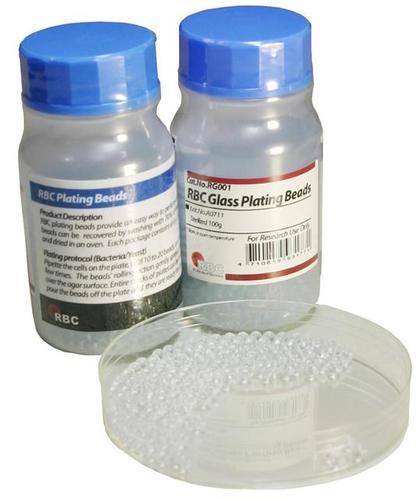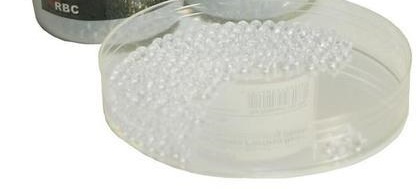Glass Plating Beads are reusable beads which helps to spread suspensions of microorganisms (bacteria or fungi) in a culture plate even much more than a conventional spreader. They are applicable when turbid suspensions of microbial cells (fungi or bacteria) are to be spread in an culture plate for such purposes as determination of the colony forming unit (CFU). These beads can also be called rattling platting beads.
Glass plating beads (Figure 1) measures 4 mm and above. They provide an efficient and easy method to achieve optimal spreading of microorganisms (bacteria or fungi) on agar culture plates. The rolling action of the plate helps the glass beads to gently spread the microbial solution (or any bacterial/fungal solution) to reach areas of the plates that they are inaccessible to spreaders. Glass platting beads are important in microbiology experiments. A common protocol for cell culture plating in Petri dishes uses glass beads to spread cells on the surface of the solid growth media.
The goal of cell plating is to separate cells contained within a small sample volume by homogeneously distributing the cell suspension over the surface of a plate. The glass (rattling) platting beads helps to achieve this. Cell plating and subsequent colony growth for determination of colony forming units (CFUs) is an important laboratory procedure in microbiology. A common protocol for cell culture plating in Petri dishes uses glass beads to spread cells on the surface of the solid growth media so that microbial cells are evenly distributed in the cultured plates.

Multiple plates containing beads and microbial solutions may be stacked and shaken simultaneously to increase spreading throughput and reduce cell stress. The beads may be recovered by washing with 70% ethanol, sterilized by autoclaving and oven dried. They provide a rapid simultaneous plating of microbial cultures (bacteria or fungi) which increases transformation efficiency of the organism during growth.
Application / usage
Glass (Rattler) Plating Beads helps to save the researcher time and effort when plating bacteria or yeast. The sterile glass beads are simply poured onto solid plated medium together with a liquid cell suspension, and the mixture is shaken to distribute the cells evenly over the medium’s surface. This allows for numerous plates to be processed quickly and efficiently. It saves time and avoids the cumbersomeness associated with the use of the inoculating loop to spread the organism on the solid culture plates.
Pour the Rattler Beads onto a series of plates, stack, and shake the plates with your hands simultaneously in a side-to-side motion. The beads can be easily removed following inversion of the plates and pouring off from the plate lids. Using the Rattler Plating Beads is simple, easy, and saves you time. The beads come sterile in polycarbonate bottles and can be reused following cleaning, washing and disinfection using 70% ethanol. The rattling nature of the beads can make them to litter around the lab – so care should be taken when making use of them because they could easily bounce off from the container.
Sources:
Discover more from Microbiology Class
Subscribe to get the latest posts sent to your email.





